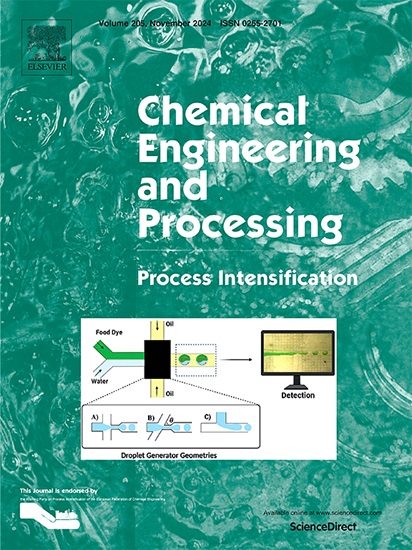Double vapor recompression strategy as a retrofit solution for the conventional benzene-toluene-xylene distillation
IF 3.8
3区 工程技术
Q3 ENERGY & FUELS
Chemical Engineering and Processing - Process Intensification
Pub Date : 2025-05-30
DOI:10.1016/j.cep.2025.110382
引用次数: 0
Abstract
The benzene-toluene-xylene (BTX) mixture stands out as one of the most important in the petrochemical industry. In an effort to improve operational conditions and enhance the sustainability of separation systems, new technologies are continuously developed. Thus, this study aims to evaluate the potential economic and environmental benefits of two optimal double vapor recompression schemes applied to the conventional BTX separation plant (DVR and DVRC), while contrasting the outcomes with two previous configurations proposed for the same system, which incorporate the divided-wall strategy, with (DWC-VR) and without (DWC) vapor recompression. The economic analysis shows that the DVRC configuration achieves the lowest total annual cost (TAC) at $12.98 million/year, followed by DVR ($13.09 million/year) and DWC-VR ($13.36 million/year). In terms of environmental performance, DVRC presents the lowest CO₂ emissions, offering an 8.6 % reduction over DWC-VR. However, DWC-VR leads to a greater reduction in water consumption, surpassing DVRC by approximately 34 %. These results suggest that DVRC may be a more suitable configuration for retrofitting existing, older plants worldwide, offering both cost and environmental benefits. On the other hand, DWC-VR can be considered as a more complex improvement and revamping alternative, particularly for new projects or advanced process upgrades.

双蒸汽再压缩策略作为传统苯-甲苯-二甲苯精馏的改进方案
苯-甲苯-二甲苯(BTX)混合物是石化工业中最重要的一种。为了改善操作条件和提高分离系统的可持续性,不断开发新技术。因此,本研究旨在评估应用于传统BTX分离装置(DVR和DVRC)的两种最佳双蒸汽再压缩方案的潜在经济效益和环境效益,并将结果与之前提出的同一系统的两种配置进行对比,包括(DWC- vr)和(DWC)蒸汽再压缩。经济分析显示,DVRC配置的年总成本(TAC)最低,为1298万美元/年,其次是DVR(1309万美元/年)和DWC-VR(1336万美元/年)。在环保性能方面,DVRC的二氧化碳排放量最低,比DWC-VR减少了8.6%。然而,DWC-VR导致更大的用水量减少,超过DVRC约34%。这些结果表明,DVRC可能是一种更合适的配置,用于改造现有的,世界范围内的旧工厂,提供成本和环境效益。另一方面,DWC-VR可以被视为更复杂的改进和改造替代方案,特别是对于新项目或高级流程升级。
本文章由计算机程序翻译,如有差异,请以英文原文为准。
求助全文
约1分钟内获得全文
求助全文
来源期刊
CiteScore
7.80
自引率
9.30%
发文量
408
审稿时长
49 days
期刊介绍:
Chemical Engineering and Processing: Process Intensification is intended for practicing researchers in industry and academia, working in the field of Process Engineering and related to the subject of Process Intensification.Articles published in the Journal demonstrate how novel discoveries, developments and theories in the field of Process Engineering and in particular Process Intensification may be used for analysis and design of innovative equipment and processing methods with substantially improved sustainability, efficiency and environmental performance.

 求助内容:
求助内容: 应助结果提醒方式:
应助结果提醒方式:


